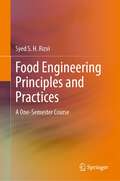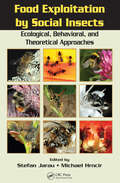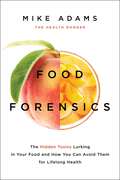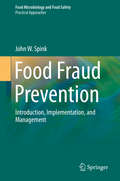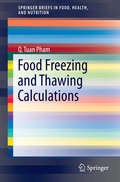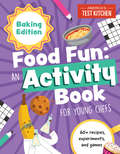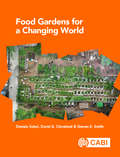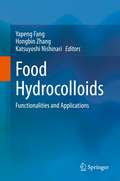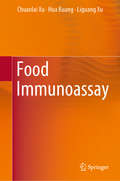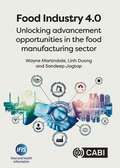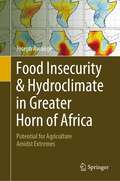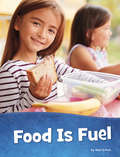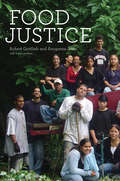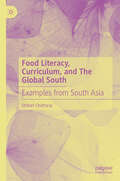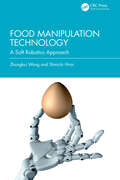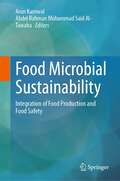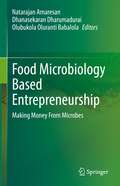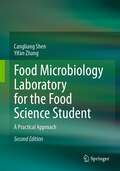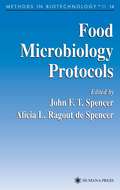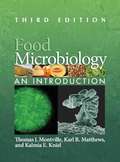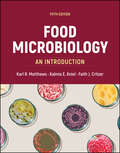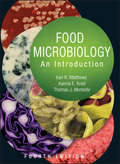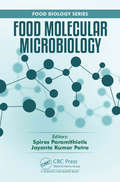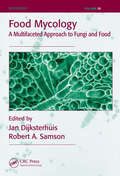- Table View
- List View
Food Engineering Principles and Practices: A One-Semester Course
by Syed S. RizviThis textbook is designed for a one-semester course on Food Engineering, and it offers a concise, in-depth and integrated introduction to the fundamental engineering and physicochemical principles and practices of utility in food processing and manufacturing operations. The textbook includes topics mandated by the Institute of Food Technologists for accreditation of Food Science curricula and helps prepare the students better for taking advance courses related to unit operations in food manufacturing. It is also relevant for Food Process Engineering courses, containing materials that most instructors can cover in three semester hours of instruction. In the first three chapters, readers will find an overview of the basic knowledge of physics and chemistry and an introduction to the engineering language needed to eliminate confusion going forward. In the following chapters, the author covers the main concepts of food thermodynamics, heat transfer–radiation in foodmaterials, mass transfer and fluid dynamics in food, along with real-life examples and exercises to help students relate better to the topics. The author also gives a brief introduction to the main mathematical and analytical concepts required in food engineering.This textbook equips readers to understand a diversity of food engineering related topics and each chapter is enriched with practical examples and Check Your Understanding sections, as well as several problems. The textbook is aimed at undergraduate food science students in their first required introductory food engineering course, but practitioners involved in designing, optimizing, and managing the processing of food products will also find it a useful account.
Food Exploitation By Social Insects: Ecological, Behavioral, and Theoretical Approaches
by Stefan Jarau Michael HrncirOmnipresent in virtually all terrestrial ecosystems and of undisputed ecological and economical importance, the study of social insects is an area that continues to attract a vast number of researchers. As a consequence, a huge amount of information about their biology and ecology has accumulated. Distilling this scattered information into a highly
Food Forensics: The Hidden Toxins Lurking in Your Food and How You Can Avoid Them for Lifelong Health
by Mike AdamsWhat's really in your food? Award-winning investigative journalist and clean food activist Mike Adams, the "Health Ranger," is founder and editor of Natural News, one of the top health news websites in the world, reaching millions of readers each month. Now, in Food Forensics, Adams meticulously tests groceries, fast foods, dietary supplements, spices, and protein powders for heavy metals and toxic elements that could be jeopardizing your health. To conduct this extensive research, Adams built a state-of-the-art laboratory with cutting-edge scientific instruments. Publishing results of metal concentrations for more than 800 different foods, Food Forensics is doing the job the FDA refuses to do: testing off-the-shelf foods and sharing the findings so the public can make informed decisions about what they consume or avoid. In Food Forensics, you'll discover little-known truths about other toxic food ingredients such as polysorbate 80, MSG, sodium nitrite, pesticides, and weed killers such as glyphosate. Adams reveals stunning, never-before-reported details of heavy metals found in recycled human waste used on crops and in parks, and he explains how industrial pollution causes mercury, lead, and cadmium to end up in your favorite protein powders. This book will forever change your view of food safety, regulation, and manufacturing. When you know what's really in your food, you can start making changes to protect yourself against serious diseases like cancer, all while maximizing your natural immune defenses against infection and disease.
Food Fraud Prevention: Introduction, Implementation, and Management (Food Microbiology and Food Safety)
by John W. SpinkThis textbook provides both the theoretical and concrete foundations needed to fully develop, implement, and manage a Food Fraud Prevention Strategy. The scope of focus includes all types of fraud (from adulterant-substances to stolen goods to counterfeits) and all types of products (from ingredients through to finished goods at retail). There are now broad, harmonized, and thorough regulatory and standard certification requirements for the food manufacturers, suppliers, and retailers. These requirements create a need for a more focused and systematic approach to understanding the root cause, conducting vulnerability assessments, and organizing and implementing a Food Fraud Prevention Strategy. A major step in the harmonizing and sharing of best practices was the 2018 industry-wide standards and certification requirements in the Global Food Safety Initiative (GFSI) endorsed Food Safety Management Systems (e.g., BRC, FSSC, IFS, & SQF). Addressing food fraud is now NOT optional – requirements include implementing a Food Fraud Vulnerability Assessment and a Food Fraud Prevention Strategy for all types of fraud and for all products. The overall prevention strategy presented in this book begins with the basic requirements and expands through the criminology root cause analysis to the final resource-allocation decision-making based on the COSO principle of Enterprise Risk Management/ ERM. The focus on the root cause expands from detection and catching bad guys to the application of foundational criminology concepts that reduce the overall vulnerability. The concepts are integrated into a fully integrated and inter-connected management system that utilizes the Food Fraud Prevention Cycle (FFPC) that starts with a pre-filter or Food Fraud Initial Screening (FFIS). This is a comprehensive and all-encompassing textbook that takes an interdisciplinary approach to the most basic and most challenging questions of how to start, what to do, how much is enough, and how to measure success.
Food Freezing and Thawing Calculations
by Q. Tuan PhamFreezing time and freezing heat load are the two most important factors determining the economics of food freezers. This Brief will review and describe the principal methods available for their calculation. The methods can be classified into analytical methods, which rely on making physical simplifications to be able to derive exact solutions; empirical methods, which use regression techniques to derive simplified equations from experimental data or numerical calculations and numerical methods, which use computational techniques such as finite elements analysis to solve the complete set of equations describing the physical process. The Brief will evaluate the methods against experimental data and develop guidelines on the choice of method. Whatever technique is used, the accuracy of the results depends crucially on the input parameters such as the heat transfer coefficient and the product's thermal properties In addition, the estimation methods and data for these parameters will be reviewed and their impacts on the calculations will be evaluated. Freezing is often accompanied by mass transfer (moisture loss, solute absorption), super cooling and nucleation and may take place under high pressure conditions; therefore methods to take these phenomena into account will also be reviewed.
Food Fun An Activity Book for Young Chefs: Baking Edition: 60+ recipes, experiments, and games (Young Chefs Series)
by America's Test Kitchen KidsFrom the creators of the #1 New York Times Bestseller The Complete Cookbook for Young Chefs, comes the second in a series of interactive workbooks for kids ages 8 to 12 who want recipes, science experiments, hands-on activities, and games--all about baking! Use the kitchen as your classroom, no school involved!Does salt make sweet treats taste even sweeter? Why do you have to let pizza dough rest before shaping it? Can you tell the difference between cookies baked with white sugar and cookies baked with brown sugar? Plus easy, kid-tested and kid-approved recipes for spiced applesauce muffins, almost no-knead bread, cake pan pizza, blondies, and more, Kitchen Explorers! Baking Edition brings the kitchen alive with fun baking-centric science experiments and art projects (edible and otherwise). Puzzles, word games, coloring pages and beyond will keep kids occupied and engaged.
Food Gardens for a Changing World
by David A. Cleveland Daniela Soleri Steven E. SmithFood gardening is becoming increasingly popular, as people look for new ways to live more sustainably and minimize harm to the environment. This book addresses the 21st century trends which bring new challenges to food gardening - anthropogenic climate change, environmental degradation, natural resource scarcity, and social inequity - and explains the basic biological, ecological and social concepts needed to understand and respond to them. Examples throughout the text demonstrate how to successfully use these concepts, while supporting gardeners' values, and their goals for themselves, their communities and the world.
Food Gardens for a Changing World
by David A. Cleveland Daniela Soleri Steven E. SmithFood gardening is becoming increasingly popular, as people look for new ways to live more sustainably and minimize harm to the environment. This book addresses the most pressing challenges facing food gardening in the 21st century - worldwide changes in climate, the environment, natural resources, and communities - and the basic biological, ecological and social concepts which influence our understanding. Examples throughout the text demonstrate how gardeners can use these theories to their advantage.
Food Hydrocolloids: Functionalities and Applications
by Katsuyoshi Nishinari Yapeng Fang Hongbin ZhangThe book introduces the definition, classification, source and structure of hydrocolloids and provides a comprehensive description of their functionalities and food-related applications. The emphasis is put on the basic concepts and mechanisms underlying functionalities, and the new developments in fundamental knowledge and practice. The book would be useful for students or professionals working in the fields of food science & technology, and biopolymers etc. It would help to organize hydrocolloids knowledge in a more systematic framework and enlighten further profound investigations.
Food Immunoassay
by Chuanlai Xu Hua Kuang Liguang XuThis book systematically covers immunoassays for food, presenting detailed approaches such as antigen design, food matrix pre-treatment and detection format optimization for 9 classes of food hazards and nutrition constituents. Offering ideas on how to improve the efficiency of recognized xenobiotics and food contents, this practical book also describes the discovery and utilization of novel immune agents like aptamer and molecular imprinted polymers in food analysis. It is intended for a broad range of areas, including biologists and food chemists, and is sure to become a key reference resource for students and professionals alike.
Food Industry 4.0: Unlocking Advancement Opportunities in the Food Manufacturing Sector
by Dr Wayne Martindale Dr Linh Duong Dr Sandeep JagtapThis book provides industry insights and fresh ideas for the advancement of the most vital global industry - food. Drawing on their industry and academic expertise the authors have identified three controlling aspects of food business operations that can unleash long term success: consumer health and wellbeing; product and process sustainability; and harnessing advances in digitalization.. If developed to their maximum potential these factors have the capability to revolutionize the food sector. Food Industry 4.0 highlights advancement opportunities for the food manufacturing sector, including innovation in products, processes and services, as it seeks to combine productive, efficient and sustainable practices. The contents address: Mapping data, new approaches for food system applications. The perfect meal and making a balanced global diet possible. Industry 4.0 applications in the food sector: robotics and automation, big data, Internet of Things, cybersecurity. Resource utilization in the food manufacturing sector. Resilience and sustainability in food supply chains. Environmental and social governance in our food system. It is of significant benefit to food industry practitioners working in operational and product development roles, academic researchers, policy makers, students, and food sector professionals.
Food Insecurity & Hydroclimate in Greater Horn of Africa: Potential for Agriculture Amidst Extremes
by Joseph AwangeThis book will benefit users in food security, agriculture, water management, and environmental sectors. It provides the first comprehensive analysis of Greater Horn of Africa (GHA)’s food insecurity and hydroclimate using the state-of-the-art Gravity Recovery and Climate Experiment (GRACE) and its Follow-on (GRACE-FO)’s, centennial precipitation, hydrological models’ and reanalysis’ products. It is here opined that GHA is endowed with freshwater (surface and groundwater) being home to the world's second largest freshwater body (Lake Victoria) and the greatest continental water towers (Ethiopian Highlands) that if properly tapped in a sustainable way, will support its irrigated agriculture as well as pastoralism. First, however, the obsolete Nile treaties that hamper the use of Lake Victoria (White Nile) and Ethiopian Highland (Blue Nile) have to be unlocked. Moreover, GHA is bedevilled by poor governance and the ``donor-assistance” syndrome; and in 2020-2021 faced the so-called ``triple threats’’ of desert locust infestation, climate variability/change impacts and COVID-19 pandemic. Besides, climate extremes influence its meagre waters leading to perennial food insecurity. Coupled with frequent regional and local conflicts, high population growth rate, low crop yield, invasion of migratory pests, contagious human and livestock diseases (such as HIV/AIDs, COVID-19 & Rift Valley fever) and poverty, life for more than 310 million of its inhabitants simply becomes unbearable. Alarming also is the fact that drought-like humanitarian crises are increasing in GHA despite recent progress in its monitoring and prediction efforts. Notwithstanding these efforts, there remain challenges stemming from uncertainty in its prediction, and the inflexibility and limited buffering capacity of the recurrent impacted systems. To achieve greater food security, therefore, in addition to boosting GHA's agricultural output, UN Office for the Coordination of Humanitarian Affairs suggest that its “inhabitants must create more diverse and stable means of livelihood to insulate themselves and their households from external shocks”. This is a task that they acknowledge will not be easy as the path ahead is “strewn with obstacles namely; natural hazards and armed conflicts”. Understanding GHA’s food insecurity and its hydroclimate as presented in this book is a good starting point towards managing the impacts of the natural hazards on the one hand while understanding the impacts associated with extreme climate on GHA's available water and assessing the potential of its surface and groundwater to support its irrigated agriculture and pastoralism would be the first step towards “coping with drought” on the other hand.The book represents a significant effort by Prof Awange in trying to offer a comprehensive overview of the hydroclimate in the Greater Horn of Africa (GHA). Prof Eric F. Wood, NAE (USA); FRSC (Canada); Foreign member, ATSE (Australia).
Food Is Fuel (Health and My Body)
by Mari SchuhWe need food to keep our bodies going. But what are healthy foods and why should we eat them? With engaging text and colorful photos, readers learn how to make healthy food choices. Food Is Fuel includes a glossary, read more section, kid-friendly Internet sites, and an index.
Food Justice (Food, Health, and the Environment)
by Robert Gottlieb Anupama JoshiThe story of how the emerging food justice movement is seeking to transform the American food system from seed to table.In today's food system, farm workers face difficult and hazardous conditions, low-income neighborhoods lack supermarkets but abound in fast-food restaurants and liquor stores, food products emphasize convenience rather than wholesomeness, and the international reach of American fast-food franchises has been a major contributor to an epidemic of “globesity.” To combat these inequities and excesses, a movement for food justice has emerged in recent years seeking to transform the food system from seed to table. In Food Justice, Robert Gottlieb and Anupama Joshi tell the story of this emerging movement.A food justice framework ensures that the benefits and risks of how food is grown and processed, transported, distributed, and consumed are shared equitably. Gottlieb and Joshi recount the history of food injustices and describe current efforts to change the system, including community gardens and farmer training in Holyoke, Massachusetts, youth empowerment through the Rethinkers in New Orleans, farm-to-school programs across the country, and the Los Angeles school system's elimination of sugary soft drinks from its cafeterias. And they tell how food activism has succeeded at the highest level: advocates waged a grassroots campaign that convinced the Obama White House to plant a vegetable garden. The first comprehensive inquiry into this emerging movement, Food Justice addresses the increasing disconnect between food and culture that has resulted from our highly industrialized food system.
Food Literacy, Curriculum, and The Global South: Examples from South Asia
by Dishari ChattarajThis volume explores concepts and theories of food literacy to understand the interdisciplinary paradigms, perspectives, and emerging discourses in and beyond formal educational contexts in the Global South, specifically South Asia. In doing so, this volume provides a comprehensive overview of existing literature on food literacy and the methodologies utilized to study the same across the Global North and South. Furthermore, this volume reports the findings of a primary research study conducted in the domain of curriculum analysis across school education boards of six South Asian countries, including Bangladesh, Bhutan, India, Nepal, and Sri Lanka. It also documents the teaching-learning experiences and perceptions of various stakeholders from select schools and regions in India. Besides highlighting the dynamic, contextual, and place-based nature of food literacies, the volume questions the autonomous nature of literacy studies, thereby promoting a less deterministic and more sustainable, inclusive, and discursive paradigm of food literacy/literacies.
Food Manipulation Technology: A Soft Robotics Approach
by Shinichi Hirai Zhongkui WangWang and Hirai draw on their extensive experience to introduce recent technological advances in soft robotics for food manipulation and discuss their practical applications in the food preparation industry. They also describe food modeling and categorization for the purpose of robotic handling.Food manipulation is common in restaurants, kitchens, and food factories, but it currently largely relies on humans because of the lack of effective robotic systems. This book therefore explains recent manipulation technology for food handling and restaurant/kitchen automation, which is essential for food manipulation. The book covers the theoretical background of soft robotic hands; their application to different handling purposes in the food industry; their use in kitchen and restaurant automation; and their use for food recognition, property measuring, and modeling. The authors also present case studies of the development of soft robotic hands to illustrate the information and provide practical information that will be instructional for readers. Readers will gain an in-depth appreciation of the technology and its practical application to industry, which will enable them to implement this in their own work.This book is an essential read for both food technology practitioners and graduate students who are interested in food manipulation and its related technologies. It gives readers the theoretical background knowledge and practical understanding to apply this cutting-edge technology in real-world settings.
Food Microbial Sustainability: Integration of Food Production and Food Safety
by Arun Karnwal Abdel Rahman Mohammad Said Al-TawahaThis book reviews all important aspects of Microbial sustainability in food production and food safety with the aim of shedding new light on these microbes through combined understanding of traditional and novel paradigms. The book is divided into three sections, the first of which reinterprets fundamentals of food microbiology, examining the beneficial aspects of microorganisms in food and microbial responses from food environments and preservation. The second section discusses recent advances in understanding of the sustainable food production, covering, for example, agriculturally important microbes, farming microbes, and fermentation. A wide range of bio-factory issues in food production are also addressed, before turning attention to contemporary food safety approaches in the context of novel assessment methods for microbiological food characterization, improving food safety and food quality, etc. The final section is devoted to public health and its importance of microorganisms in food processing as well as the economic importance of microorganisms as this is also an increasingly important area as we move toward microbial research advances.
Food Microbiology Based Entrepreneurship: Making Money From Microbes
by Olubukola Oluranti Babalola Natarajan Amaresan Dhanasekaran DharumaduraiThis book is first part of the 3 volume set focusing on basic and advanced methods for using microbiology as an entrepreneurial venture. This book deals with the concept of entrepreneurship skills for production, cost-benefit analysis and marketing of button, oyster, milky mushroom, Ganoderma sp, Single cell protein, Breads, Cheese, Yoghurt, Wine, Beer, Probiotics, Prebiotics fermented vegetables, and Fermented Fish etc. Chapters cover the applications of microorganisms in small and large scale production to achieve a sustainable output. This book provides essential knowledge and working business protocols from all related disciplines of food and dairy industry, probiotics industry, mushroom industry, beverage and baking industry, poultry industry, and aquaculture industry etc. This book is useful to graduate students, research scholars and postdoctoral fellows, and teachers who belong to different disciplines via botany, food microbiology, biotechnology, aquaculture microbiology and poultry microbiology. The other two volumes are focused on agriculture and industrial microbiology.
Food Microbiology Laboratory for the Food Science Student: A Practical Approach
by Cangliang Shen Yifan ZhangThis book is designed to give students an understanding of the role of microorganisms in food processing and preservation; the relation of microorganisms to food spoilage, foodborne illness, and intoxication; general food processing and quality control; the role of microorganisms in health promotion; and federal food processing regulations. The listed laboratory exercises are aimed to provide a hands-on-opportunity for the student to practice and observe the principles of food microbiology. Students will be able to familiarize themselves with the techniques used to research, regulate, prevent, and control the microorganisms in food and understand the function of beneficial microorganism during food manufacturing process. The second edition add 5 new chapters including “Chapter 10 -Thermal inactivation of Escherichia coli O157:H7 in mechanically tenderized beef steaks and color measurements”, “Chapter 11-Evaluate antimicrobial activity of chlorine water on apples and measurement of free chlorine concentrations”, “Chapter 12-Evaluate cross-contamination of Salmonella on tomatoes in wash water using most probable number (MPN) technique”, “Chapter 15-DNA extraction and purity determination of foodborne pathogens”, and “Chapter 16-Practice of multiplex PCR to identify bacteria in bacterial solutions”. It also includes new lab work flowcharts for Gram-staining and endospore-staining technology in Chapter 1, pour plating and spread plating in Chapter 3, Enterotube II in Chapter 9, and Kirby Beau test procedure in Chapter 20. It includes a new sample of syllabus with the hybrid teaching of both lecture and lab sections in one course, which will assist junior faculty/instructors to develop similar lecture and lab courses.
Food Microbiology Protocols
by John F. Spencer Alicia L. Ragout de SpencerExpert laboratorians present a wide ranging set of detailed techniques for investigating the nature, products, and extent of the microorganisms involved in the manufacture and spoilage of foodstuff. The methods cover pathogenic organisms that cause spoilage, microorganisms in fermented foods, and microorganisms producing metabolites that affect the flavor or nutritive value of foods. Included in the section dealing with fermented foods are procedures for the maintenance of lactic acid bacteria, the isolation of plasmid and genomic DNA from species Lactobacillus, and the determination of proteolytic activity of lactic acid bacteria. A substantial number of chapters are devoted to yeasts, their use in food and beverage production, and techniques for improving industrially important strains. Comprehensive and timely, Food Microbiology Protocols is a gold-standard collection of readily reproducible techniques essential for the study of the wide variety of microorganisms involved in food production, quality, storage, and preservation today.
Food Microbiology: An Introduction
by Thomas J. Montville Karl R. Matthews Kalmia E. KnielThis textbook presents authoritative coverage in a format designed to facilitate teaching and learning. Encourages students to venture beyond memorization and think critically to gain a broader conceptual understanding of food microbiology and acquire the understanding and skills necessary to ensure the safety of tomorrow's food supply. Introduces the genetics and molecular mechanisms important for the understanding of foodborne microbes. Includes expert perspectives on parasites, viruses and prions, and non-thermal processes. Incorporates instructors' input to further clarify complex topics in the field of food microbiology. Presents explicit learning goals to focus students on the core principles of food microbiology.
Food Microbiology: An Introduction (ASM Books)
by Karl R. Matthews Kalmia E. Kniel Faith J. CritzerLeading textbook presenting all aspects of food microbiology Food Microbiology: An Introduction presents the basics of microorganisms that impact food safety and quality, the roles of beneficial microbes, food safety regulations, and proper practices for safe and healthy foods throughout all aspects of the supply chain. This Fifth Edition has been updated to reflect advances in research and technology and threats to the global food supply while retaining the pedagogy and structure that students and professors appreciate. Written in a clear and easy-to-understand style, the book is divided into four sections: Part I introduces the fundamentals of food microbiology, including a brief history of the field, the growth processes of food microorganisms, the biology of spores and sporeformers, techniques for enumeration and detection of organisms in food, description of rapid and automated microbial methods, and a new chapter focused on antimicrobial resistance. Part II addresses important regulatory issues and focuses on foodborne pathogenic microorganisms with chapters describing the most common bacterial species that cause foodborne diseases, as well as discussion of parasites, viruses, and prions. Part III explores nonpathogenic microbes important in food, including those responsible for fermentations and food spoilage. Part IV focuses on the control of microorganisms in food, including chemical antimicrobials, biological and physical methods of food preservation, nonthermal processing, and food safety systems. Food Microbiology: An Introduction also includes updated information on: The growing threats of antimicrobial resistance and climate change and their potential impacts on the global food supplyUse of next-generation sequencing techniques in the identification of microbes in foodExpanded discussion on sanitizers, disinfectants, and nonthermal processing treatmentsUp-to-date information on the Food Safety Modernization Act, hazard analysis and critical control points, and good manufacturing practices Food Microbiology: An Introduction is an essential textbook for undergraduate and graduate students in food science, nutrition, and microbiology, providing the knowledge and tools necessary to navigate the complexities of food microbiology in the 21st century.
Food Microbiology: An Introduction (ASM Books)
by Thomas J. Montville Karl R. Matthews Kalmia E. KnielAuthoratative coverage presented in a format designed to facilitate teaching and learning.
Food Molecular Microbiology (Food Biology Series)
by Jayanta Kumar Patra Spiros ParamithiotisWith the advances in the field of molecular biology, new tools make it possible to conduct in-depth studies in food microbial communities from a molecular perspective. Information from genomic, transcriptomic, proteomic and metabolomic studies can be integrated through bioinformatic applications, thereby improving our understanding of the interactions between biotic and abiotic factors and concomitantly the physiology of starter cultures, spoilage and pathogenic microbiota. Improvements in the speed, accuracy and reliability of food quality and safety assessment have made the foundation stronger for future developments including the exploitation of gene networks and applications of nanotechnology and systems biology. This book reviews all these developments, provides an integrated view of the subject and helps in identifying areas of future development.
Food Mycology: A Multifaceted Approach to Fungi and Food (Mycology)
by Robert A. Samson Jan DijksterhuisFor millennia, the presence of fungi in food has been both boon and bane to food stores. Fungi can spoil large quantities of food and produce dangerous toxins that threaten human health; however, fungal spoilage in certain foods can produce a unique, highly prized food source and there are some very effective fungal derived medicines. A thorough un
